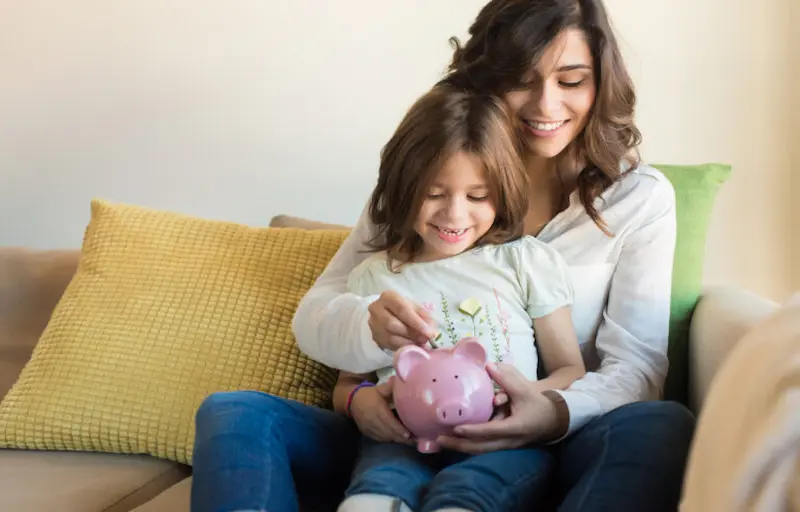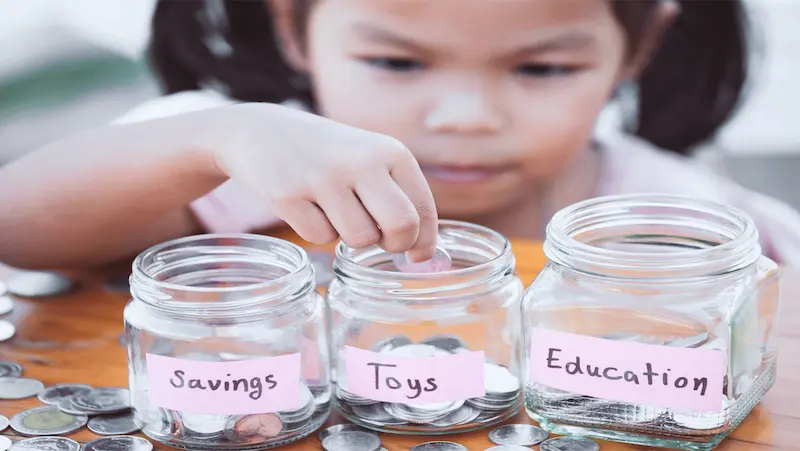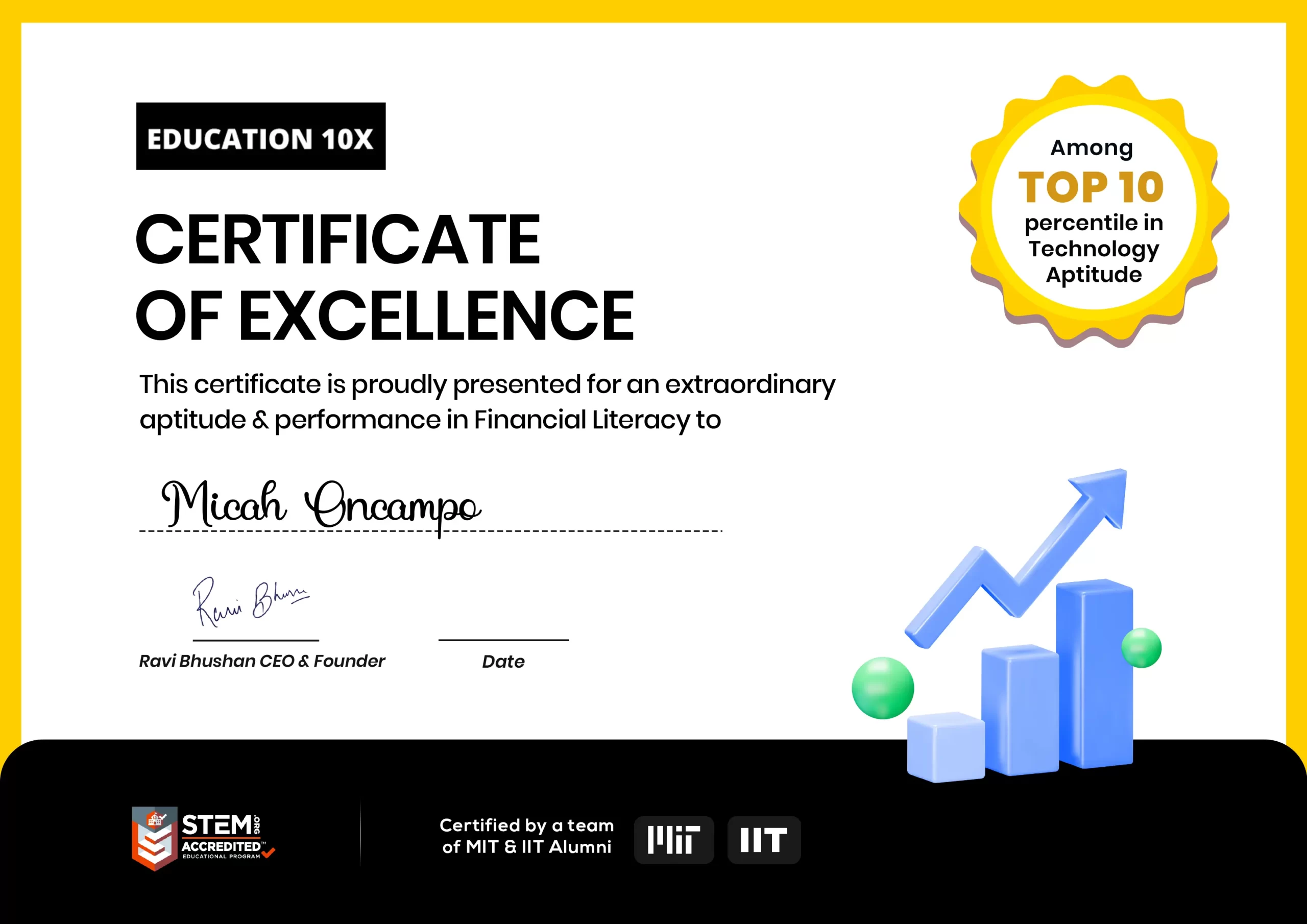Teaching children about financial responsibility is an important life skill that will serve them well in their future. One effective way to introduce them to the world of personal finance is by setting up bank accounts for children. Bank accounts provide a practical and hands-on approach to teaching children about money management, savings, and budgeting.
Table of contents
- Introduction
- When to Open a Bank Account for Your Child
- Choosing the Right Bank Account for Your Child
- Opening a Bank Account for Your Child
- Teaching Financial Responsibility through a Bank Account
- Safety and Security of Kids’ Bank Accounts
- Encouraging Savings Habits in Children
- Conclusion
- Frequently Asked Questions
Introduction
Financial education for kids is important for children because it teaches them how to manage their money wisely. It also helps them to understand the importance of saving and investing.
Here are some of the benefits of teaching financial education to children:
- They will be more likely to save and invest money. When children learn about the importance of saving and investing, they are more likely to do so themselves. This can help them to build a strong financial foundation for their future.
- They will be less likely to fall into debt. When children learn about the dangers of debt, they are less likely to take on too much debt in their own lives. This can help them to avoid financial problems in the future.
- They will be better able to make financial decisions. When children learn about different financial concepts, they are better able to make informed financial decisions. This can help them to make the most of their money and achieve their financial goals.
Bank accounts for kids can be a great way to teach children about money management. Here are some of the benefits of bank accounts for kids:
- They can learn about saving and spending. Kids can learn about the importance of saving and spending money by depositing their allowance or other earnings into a bank account. They can also learn about the concept of interest by watching their balance grow over time.
- They can learn about budgeting. Kids can learn about budgeting by setting up a budget for their spending. They can also learn about the importance of sticking to their budget by tracking their spending and seeing how much money they have left over each month.
- They can learn about fraud protection. Kids can learn about fraud protection by talking to their parents about how to protect their money from identity theft and other forms of fraud.
If you are looking for a way to teach your child about money management, a bank account for kids can be a great option. There are many different banks that offer bank accounts for kids, so you can choose one that best meets your needs.
Financial literacy for students is essential as it equips them with the knowledge and skills needed to understand the importance of money and make informed financial decisions throughout their lives.

When to Open a Bank Account for Your Child
There is no right or wrong age to open a bank account for your child. However, most financial experts suggest waiting until your child is at least 9 years old. This is because by this age, most kids are able to grasp basic money concepts, such as saving and spending. Parents are increasingly realizing the importance of imparting financial education for kids at an early age to ensure their future financial well-being.
If you do decide to open a bank account for your child before they turn 9, it’s important to choose an account that is designed for minors. These accounts typically have lower fees and higher interest rates than regular checking and savings accounts.
Different Types of Accounts Available
There are two main types of bank accounts available for minors: custodial accounts and joint accounts.
- Custodial accounts are owned by the child, but they are managed by a custodian, who is usually a parent or guardian. The custodian has the right to withdraw money from the account, but they are also responsible for making sure that the child uses the money wisely.
- Joint accounts are owned by both the child and the parent or guardian. Both parties have the right to withdraw money from the account, and they are both responsible for any fees or charges.
Which Type of Account is Right for Your Child?
The best type of account for your child will depend on your individual circumstances. If you want to give your child complete control over their money, a custodial account may be a good option. However, if you want to be able to help your child manage their money, a joint account may be a better choice.
Here are some additional things to consider when choosing a bank account for your child:
- Fees: Make sure to compare the fees associated with different accounts. Some accounts may have monthly maintenance fees, ATM fees, or overdraft fees.
- Interest rates: Some accounts offer higher interest rates than others. This can help your child’s money grow faster.
- Features: Some accounts offer additional features, such as online banking or bill pay. These features can make it easier for your child to manage their money.
Teaching Your Child About Money
Opening a bank account for your child is a great way to start teaching them about money. Here are some tips for teaching your child about money:
- Talk to them about the importance of saving: Explain to your child that saving money is important for the future. Help them set financial goals, such as saving for a new bike or a college education.
- Help them budget: Teach your child how to create a budget and track their spending. This will help them learn how to make wise financial decisions.
- Let them make mistakes: It’s okay if your child makes mistakes with their money. This is a natural part of learning. The important thing is to help them learn from their mistakes.
By opening the best savings account for kids and teaching them about money, you can help them set themselves up for financial success in the future.
Choosing the Right Bank Account for Your Child

When choosing a bank account for your child, there are a few key features and benefits to consider.
- Interest rates: Some banks offer higher interest rates on savings accounts for children. This can help your child’s money grow faster.
- ATM and debit card: Many banks offer ATM and debit cards for children. This can give your child the freedom to spend their money, but it’s important to set limits on how much they can withdraw or spend.
- Online banking: Online banking can make it easy for you to monitor your child’s account and teach them about financial responsibility.
- Fees: Some banks charge fees for their children’s accounts. Be sure to compare fees before you choose an account.
Specific Account Options that Cater to Children
There are a number of specific account options that cater to children. These accounts often have features that are designed to help children learn about money and financial responsibility. While robotics for 5-year-old kids might not directly involve finance, introducing them to basic financial concepts early on can complement their robotics education and foster a well-rounded understanding of the world.
- Starter accounts: Starter accounts are designed for children who are just starting to save money. These accounts typically have low or no fees and may offer rewards for saving, such as stickers or prizes.
- Rewards accounts: Rewards accounts are designed to encourage children to save money. These accounts may offer rewards, such as cash back or points, for using a debit card or making purchases online.
- College savings accounts: College savings accounts are designed to help parents save for their children’s college education. These accounts may offer tax advantages and may have higher interest rates than traditional savings accounts.
Teaching Financial Responsibility
Opening a bank account for your child is a great way to start teaching them about financial responsibility. Here are a few tips for teaching your child about money:
- Set a good example: Children learn by watching the adults in their lives. Make sure you set a good example by being responsible with your own money.
- Talk to your child about money: Talk to your child about the importance of saving money and making wise financial choices. Explain the difference between needs and wants.
- Help your child set financial goals: Help your child set financial goals, such as saving for a new toy or a vacation. Help them create a budget and track their spending.
- Make it fun: Make learning about money fun for your child. Play games, read books, and watch movies about money.
By opening a bank account for your child and teaching them about financial responsibility, you can help them set themselves up for financial success in the future.
Teaching kids about money includes educating them on the importance of choosing the right bank account and instilling financial responsibility from an early age.
Opening a Bank Account for Your Child

Opening a bank account for your child is a great way to teach them about financial responsibility and saving money. It can also help them build their credit history and get started on their financial future. Exploring the basics of finance for kids at an early age can lay a strong foundation for their future financial success and independence.
Here are the required documents and identification you will need to open a bank account for your child:
- Child’s birth certificate
- Parent/guardian’s ID
- Parent/guardian’s signature
- Proof of address
Here are the step-by-step instructions for opening a bank account for your child:
- Choose a bank. There are many different banks that offer accounts for minors. Do some research to find a bank that has the features you are looking for, such as low fees, ATM access, and online banking.
- Gather the required documents. Make sure you have all of the required documents listed above before you go to the bank.
- Visit a bank branch. Bring your child with you when you visit the bank. The bank representative will help you fill out the paperwork and open the account.
- Deposit money into the account. You can deposit money into the account at the bank or by using a mobile app or online banking.
- Set up parental controls. Many banks offer parental controls that allow you to track your child’s spending and set limits on how much they can spend.
Opening a bank account for your child is a great way to teach them about financial responsibility and saving money. It can also help them build their credit history and get started on their financial future.
Teaching Financial Responsibility through a Bank Account

A bank account is a great way to teach children about financial responsibility. It can help them learn about saving, spending, and budgeting. Here are some tips for teaching financial responsibility through a bank account:
- Open a savings account for your child. This will give them a place to deposit their money and watch it grow over time.
- Set up regular deposits into the account. This could be from an allowance, chores, or part-time job.
- Talk to your child about their goals for the money. Do they want to save for a new toy, a vacation, or a car?
- Help your child create a budget. This will help them track their spending and make sure they don’t overspend.
- Allow your child to make some of their own financial decisions. This will help them learn about the consequences of their choices.
A bank account can be a great tool for teaching children about financial responsibility. By following these tips, you can help your child develop good financial habits that will last a lifetime.
Here are some additional strategies for teaching money management:
- Talk to your children about money openly and honestly. Answer their questions in a straightforward way and let them know that you are always available to help them with their financial questions.
- Set a good example. Children learn by watching the adults in their lives. Make sure you are setting a good example by being responsible with your own money.
- Teach your children about the value of saving. Help them set savings goals and make a plan for how they will reach those goals.
- Teach your children about the importance of budgeting. Help them create a budget that allows them to save money and still have money to spend on things they want.
- Teach your children about the dangers of debt. Help them understand that debt can be a trap and that it is important to avoid it whenever possible.
By following these tips, you can help your children develop good financial habits that will serve them well throughout their lives.
The role of a bank account in this process
A bank account can play an important role in teaching children about financial responsibility. It can provide a safe and secure place for children to store their money, and it can help them learn about the basics of saving, spending, and budgeting. The interactive banking game for kids offers a fun and engaging way to introduce them to the world of finance and money management.
When choosing a bank account for your child, it is important to consider the following factors:
- Fees: Some banks charge fees for basic bank accounts, so be sure to compare fees before you choose an account.
- Interest rates: Some banks offer higher interest rates on savings accounts, so you may want to consider an account with a higher interest rate if your child is saving for a long-term goal.
- Features: Some banks offer features such as ATM cards, online banking, and mobile banking, which can be helpful for children who are learning about money management.
Once you have chosen a bank account for your child, be sure to talk to them about how to use the account responsibly. Explain the importance of saving money, and help them set goals for their savings. You may also want to teach them about the dangers of debt and how to avoid it.
BrightChamps offers various opportunities to know about various ways for kids to make money while also emphasizing the importance of money management and financial responsibility.
By teaching your child about financial responsibility, you can help them set themselves up for a successful financial future.
Safety and Security of Kids’ Bank Accounts

Banks take a number of safety measures to protect kids’ bank accounts. These measures include:
- Passwords and PINs: Banks require children to create passwords and PINs for their accounts. These passwords and PINs should be kept secret from anyone else.
- ATM limits: Banks often set limits on how much money children can withdraw from ATMs. This helps to prevent children from overspending.
- Fraud protection: Banks have fraud protection measures in place to help detect and prevent fraud. These measures include monitoring account activity for suspicious transactions and blocking unauthorized transactions.
Tips for Monitoring and Protecting the Account
In addition to the safety measures taken by banks, parents can also take steps to monitor and protect their children’s bank accounts. These steps include:
- Review account statements regularly: Parents should review their children’s account statements regularly to check for any unauthorized transactions.
- Set up alerts: Parents can set up alerts with their bank to notify them of any suspicious activity on their child’s account.
- Teach children about online safety: Parents should teach their children about online safety, including how to spot and avoid scams.
- Be a role model: Parents should set a good example for their children by being responsible with their own money.
By taking these steps, parents can help to ensure that their children’s bank accounts are safe and secure. Incorporating practical money lessons for kids into their curriculum can empower them with essential financial skills from a young age.
Here are some additional tips for teaching financial responsibility to children:
- Start early: The earlier you start teaching your children about money, the better. Even young children can learn about saving, spending, and budgeting.
- Make it fun: There are many ways to make learning about money fun. You can play games, read books, and watch movies about money.
- Be a role model: Children learn by watching the adults in their lives. Be sure to model good financial habits, such as saving money and paying bills on time.
- Talk to your children about your own financial situation: Don’t be afraid to talk to your children about your own financial situation. This will help them to understand the importance of making wise financial choices.
- Help your children set financial goals: Help your children set financial goals, such as saving for a car or a college education. This will help them to stay motivated and on track.
- Be patient: It takes time to learn about money. Be patient with your children as they learn and grow.
Encouraging Savings Habits in Children

Here are some practical advice for instilling saving habits in children and fun and engaging ways to motivate them:
- Start early. The earlier you start teaching your children about money, the better. Even young children can understand the concept of saving, and they’re more likely to develop good financial habits if they’re exposed to them from a young age.
- Set a good example. Children learn by watching the adults in their lives, so it’s important to set a good example when it comes to money. Talk about your own financial decisions with your children, and let them see you saving and investing.
- Give your children an allowance. An allowance is a great way to teach your children about the value of money and how to budget. Set a fair allowance based on your child’s age and chores, and make sure they understand that they have to earn their money.
- Help your children set goals. Once your child has an allowance, help them set some financial goals. This could be anything from saving up for a new toy to saving for college. When your child has a goal to work towards, they’re more likely to be motivated to save.
- Make saving fun. There are a number of ways to make saving fun for children. You could start a savings jar, or you could open a savings account specifically for your child. You could also play games or do activities that teach your child about money.
- Be patient. It takes time to develop good financial habits. Don’t get discouraged if your child doesn’t get it right away. Just keep talking to them about money, and keep setting a good example. With time and patience, they’ll learn how to manage their money wisely.
Here are some fun and engaging ways to motivate children to save:
- Set up a savings challenge. This could be anything from a weekly savings challenge to a month-long challenge. You could also set up a competition between your children to see who can save the most money.
- Give your child a reward for saving. This could be anything from a small toy to a special outing. When your child reaches their savings goal, be sure to give them the reward they’ve earned.
- Make saving a family affair. Get everyone in the family involved in saving money. This could mean setting up a family savings jar or opening a family savings account. When everyone is working together to save money, it’s more likely to happen.
- Talk to your child about the importance of saving. Explain to your child why it’s important to save money. This could include things like saving for a rainy day, saving for a big purchase, or saving for retirement.
- Make saving fun. There are a number of ways to make saving fun for children. You could play games, do activities, or read books about money. When saving is fun, children are more likely to do it.
Empower Your Child’s Financial Future with FinChamps, Where Financial Literacy Turns Kids into Responsible Adults!
By following these tips, you can help your children develop good financial habits that will last a lifetime. Also, Teaching budgeting for kids is a valuable life skill that equips them with the knowledge to manage money responsibly as they grow older.
Conclusion
In conclusion, teaching financial responsibility to children is a crucial life skill that will benefit them throughout their lives. Introducing them to bank accounts at an early age is a practical and effective way to instill sound money management habits.
By understanding the basics of banking, children can learn the value of saving, budgeting, and making informed financial decisions. Additionally, bank accounts provide a safe and secure platform for children to manage their money, fostering independence and responsibility.
As parents and educators, it is our responsibility to equip the next generation with the tools they need to navigate the complex world of finance. By teaching children about bank accounts and financial responsibility, we are empowering them to build a solid foundation for a successful financial future.
To get your hands on more such educational and free resources on coding, robotics, game development, etc., do check out the Brightchamps Blog Page now!
Nurturing Young Innovators: Join BrightChamps and Watch Your Child Excel in Robotics, Finance, and Coding!
Frequently Asked Questions
Opening a bank account for your child helps teach them financial responsibility and the importance of saving money for the future.
The age typically appropriate for a child to have a bank account varies, but many banks offer accounts for children as young as 13 or 14 years old.
Generally, you will need the child’s birth certificate, Social Security number, and the parent or guardian’s identification and proof of address to open a bank account for a child.
Fees associated with kids’ bank accounts can vary depending on the bank and the type of account, but many banks offer fee-free or low-cost options specifically designed for children.
You can teach your child about money management by involving them in the process of managing their bank account, setting savings goals, and tracking their expenses and savings.
When choosing a bank account for your child, look for features such as low fees, educational resources, parental controls, and the ability to set up automatic transfers or allowances.
Yes, children can have debit cards linked to their bank accounts, but the availability may vary depending on the bank and the child’s age.
Kids’ bank accounts are typically safe and secure, as banks have security measures in place to protect their customers’ accounts and personal information.
To monitor your child’s bank account activity, you can set up online or mobile banking access, receive account notifications, and review their transactions regularly with them.
Encourage regular savings habits in children by setting savings goals, offering incentives or matching their savings, discussing the importance of saving, and involving them in financial discussions and decision-making.


 We are an army of educators and passionate learners from BrightChamps family, committed to providing free learning resources to kids, parents & students.
We are an army of educators and passionate learners from BrightChamps family, committed to providing free learning resources to kids, parents & students.







